MARIANI’S
Virtual Gourmet
April 23,
2017
NEWSLETTER
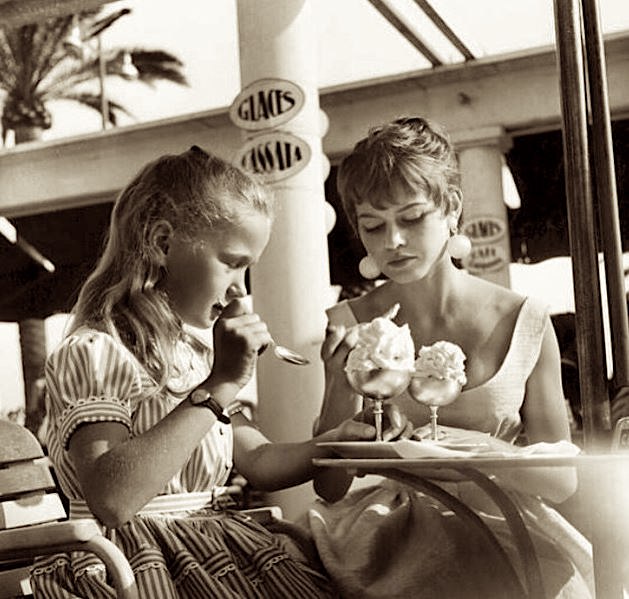
❖❖❖
IN THIS ISSUE
DINING IN DUBLIN, Part Two
By John Mariani
NEW YORK CORNER
LAMANO and SARAGHINA
By John Mariani
NOTES FROM THE WINE CELLAR
LEDE WINES AIM FOR PURITY OF STYLE
By John Mariani
Part Two
By John Mariani
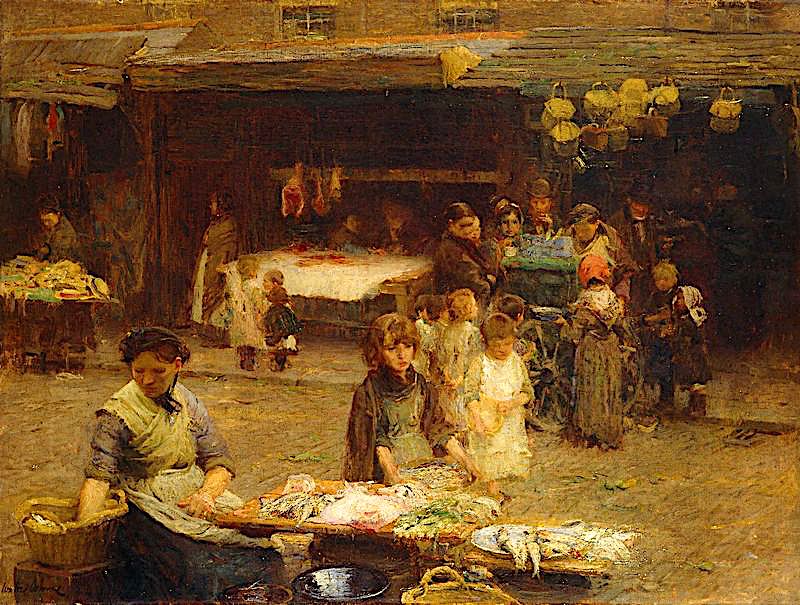
"The Fish Market, Patrick Street" (1893) by Walter Osbourne
As I wrote a few weeks ago,
Dublin has an impressive fine dining scene, but I
assume visitors will also be looking for something
more in the Irish culinary tradition. Fortunately,
gastropubs and bistros have popped up to meet the
demand. Here are some you should consider. (Just
don’t ask for corned beef and cabbage.)
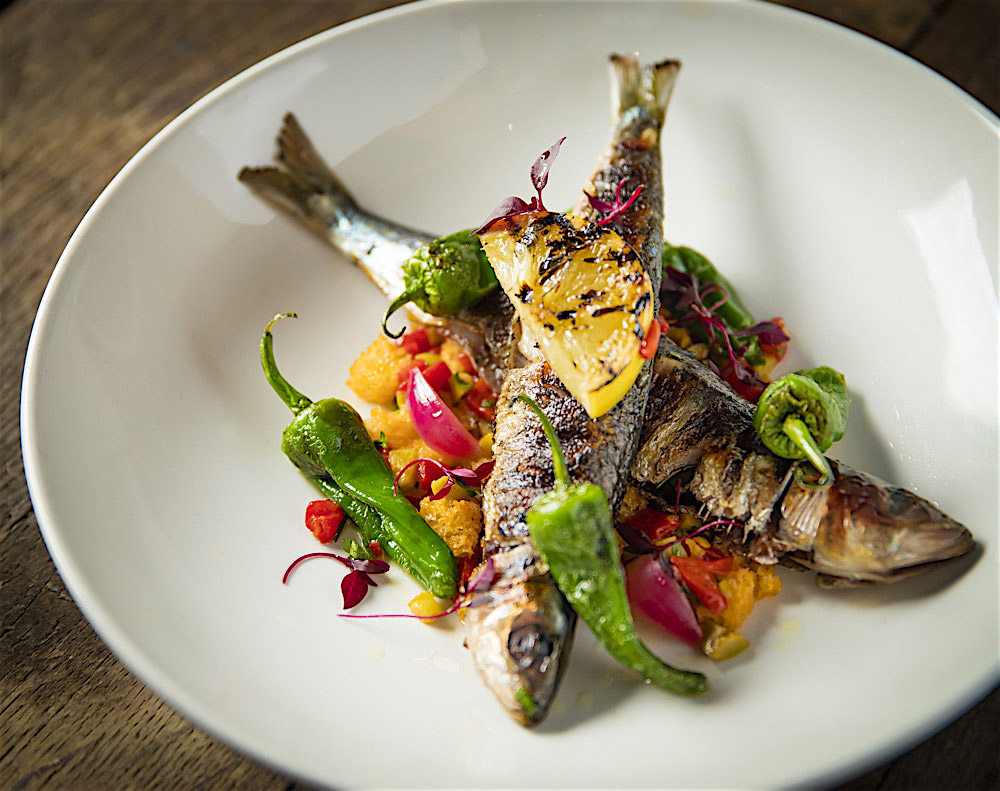 COPPINGER
ROW
COPPINGER
ROW
1
Coppinger Row
353-1-672-9884
The
owners of the casual and cozy Coppinger Row, near
Grafton Street, don’t brag or even explain much
about their establishment on their website, letting
the “Mediterranean plates, bold wines &
signature cocktails” speak for themselves. Apparently,
they have been heard loud and clear, for this is one
of Dublin’s overnight hits.
Chef Troy McGuire sets a menu of
six appetizers and six mains, whose brevity is
expressive of knowing what he can do best with what
he obtains that day (his suppliers are listed). This
might include garlic and chili prawns cooked à la plancha
(11.50€ or 14.50€) and delicious dressed crab and
crayfish with basil,
lemon and chili oil (13.75€). Irish
seafood is truly wonderful when treated simply.
basil,
lemon and chili oil (13.75€). Irish
seafood is truly wonderful when treated simply.
Portions are generous, and I’d
certainly recommend one of the fish dishes for an
entrée, like the pan-fried hake with mussels, baby
potatoes and a light curry broth (26.5€). But it
would be difficult for a true trencherman not to
order either the crispy pork belly with mustard
mash, caramelized apples and black pudding (26€), or
the salt marsh duck breast with fondant potato,
pickled cabbage and Muscat (27.50€).
Ordering sticky toffee pudding seems
to me requisite in a Dublin restaurant, but there is
also a selection of farmhouse cheeses to consider.
The best deal here is the
42.50€ fixed price dinner. Sunday through Wednesday
there is an early bird dinner with two courses at
22.5€ and three courses at 25.5€ with wine
additional. A 12.5% service charge is added to the
bill.
Open Mon.-Fri. for lunch; weekends
for brunch, Nightly for dinner.
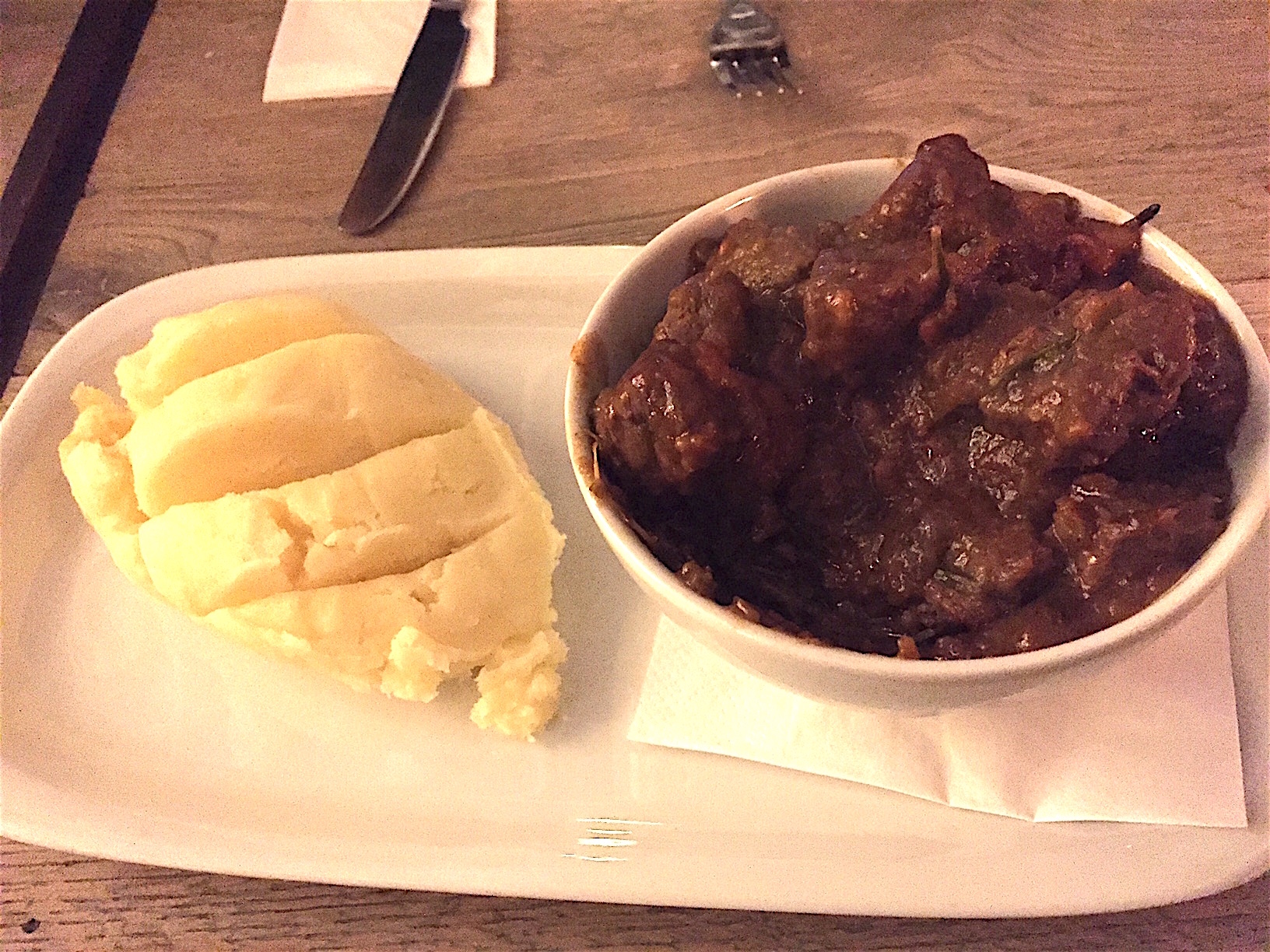 THE
FRONT DOOR
THE
FRONT DOOR
15
Dame
Street
677-8485
Of
course, eating out in Dublin will inevitably drive
one to more traditional 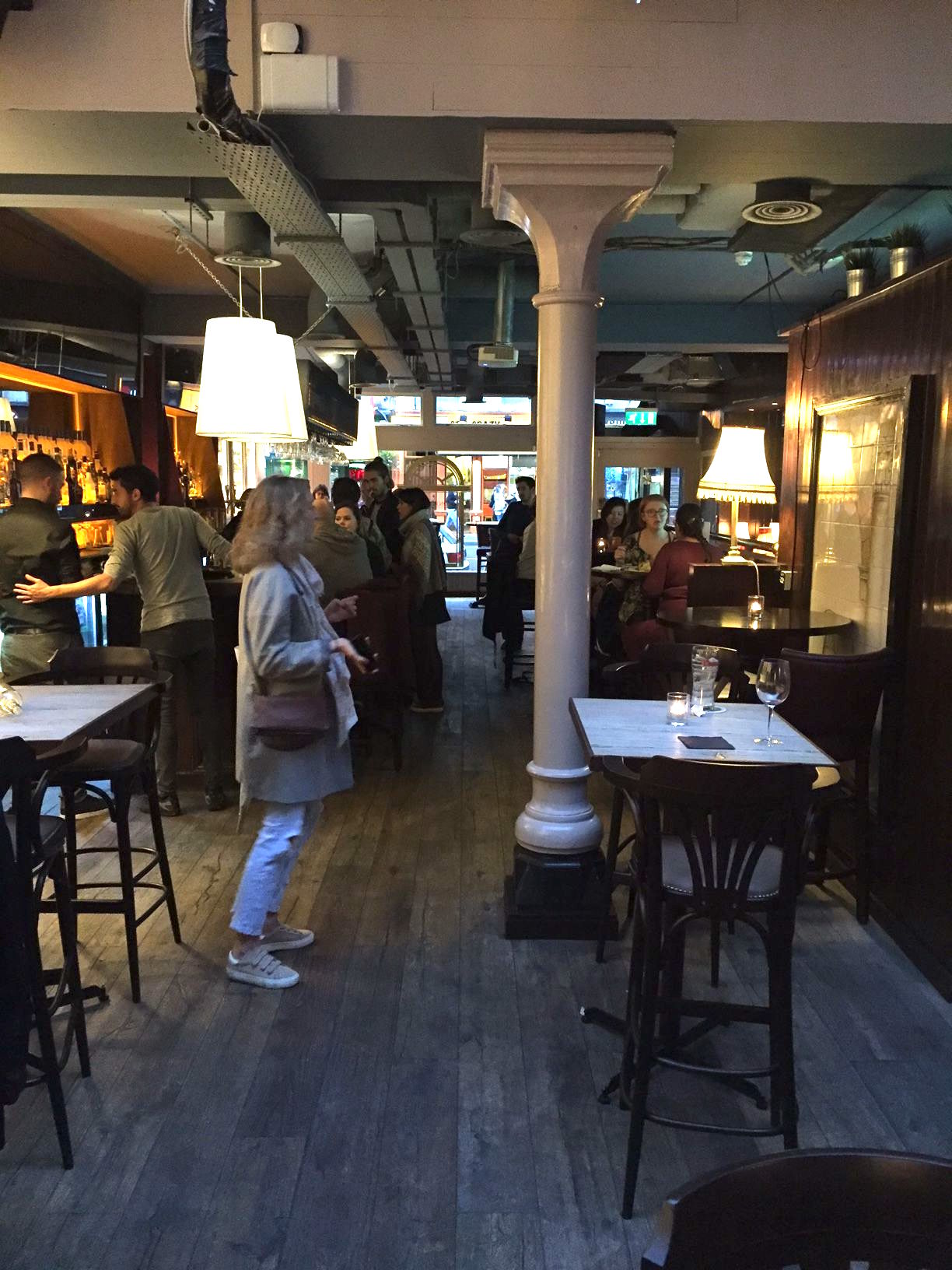 fare, and
while most upscale pubs around town serve decent
versions of the usual grub, The Front Door, which is
very pub-like up front, is less than 18 months old
and quite serious about its menu. Nearby
Trinity College, it draws a young crowd; a stone’s
throw from The Olympia Theater, it gets a pre- and
after-theater clientele; and the place has caught on
with visitors from other countries, so you get a
good mix and a lot of conviviality. The Irish
are constitutionally
incapable of talking to the next person
over without clinking glasses.
fare, and
while most upscale pubs around town serve decent
versions of the usual grub, The Front Door, which is
very pub-like up front, is less than 18 months old
and quite serious about its menu. Nearby
Trinity College, it draws a young crowd; a stone’s
throw from The Olympia Theater, it gets a pre- and
after-theater clientele; and the place has caught on
with visitors from other countries, so you get a
good mix and a lot of conviviality. The Irish
are constitutionally
incapable of talking to the next person
over without clinking glasses.
There’s traditional Irish music every Sunday
to bolster an already ebullient atmosphere, but one
that is, surprisingly, not raucously loud, as
elsewhere.
I opted to try both the
first-rate fish and chips with a pea puree, tartar
sauce and country fried potatoes (15€) and a hefty
Irish beef stew (above)
with buttered mashed potatoes (14€).
The wine list is short, the beer
list mounting to two dozen labels.
Open for lunch and dinner daily.
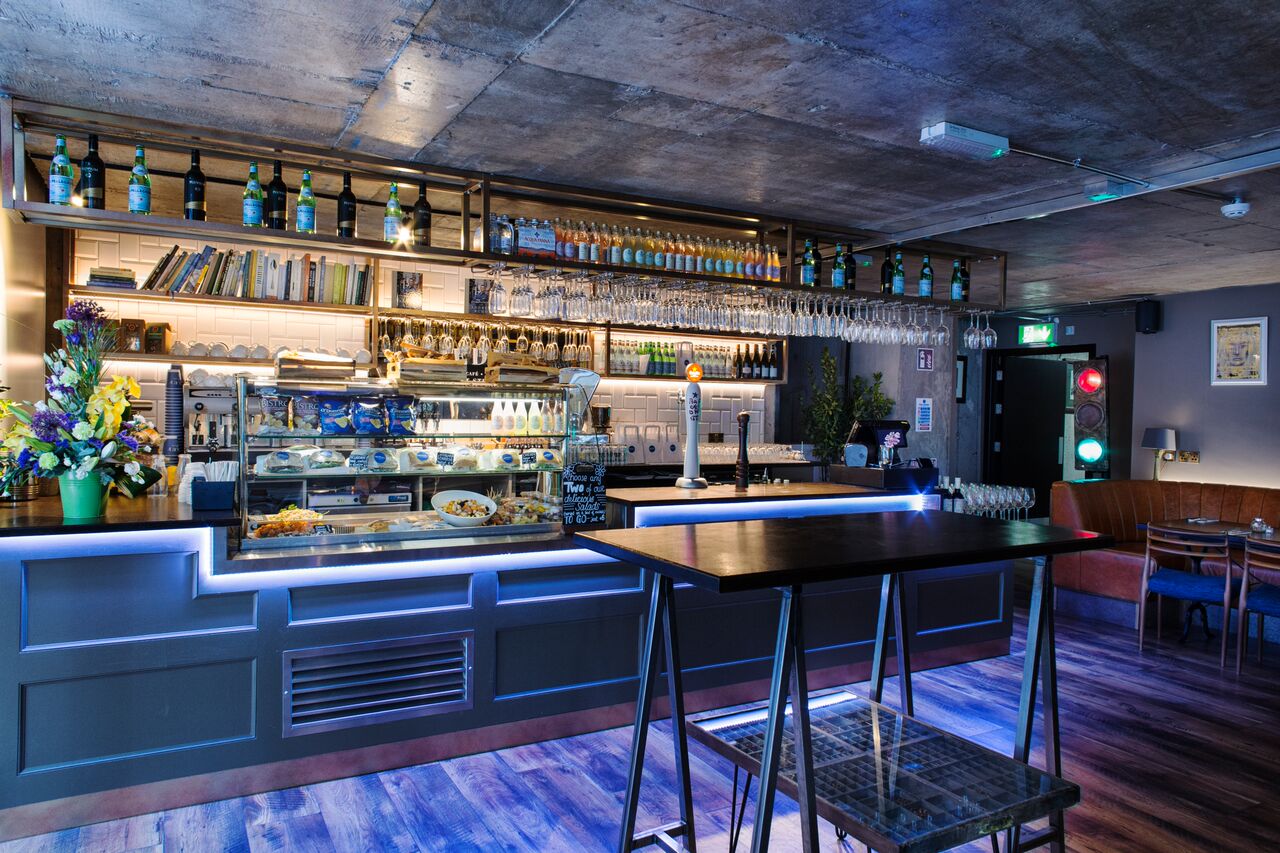 MEDLEY
MEDLEY
Fleet
Street
East
353-1-555-7116
A
good indication of the global reach of Dublin’s
modern restaurants will be found at the new Medley,
in the old Irish
Times building, set on two levels, downstairs
for a hearty lunch or take-out, and upstairs for
events and catering. It’s been called by the local
press a “bustling New York-style café bistro,” which
seems to make sense.
The highly entrepreneurial Andrew
Rudd has built his career on cooking
demonstrations, private catering and he is to be
found 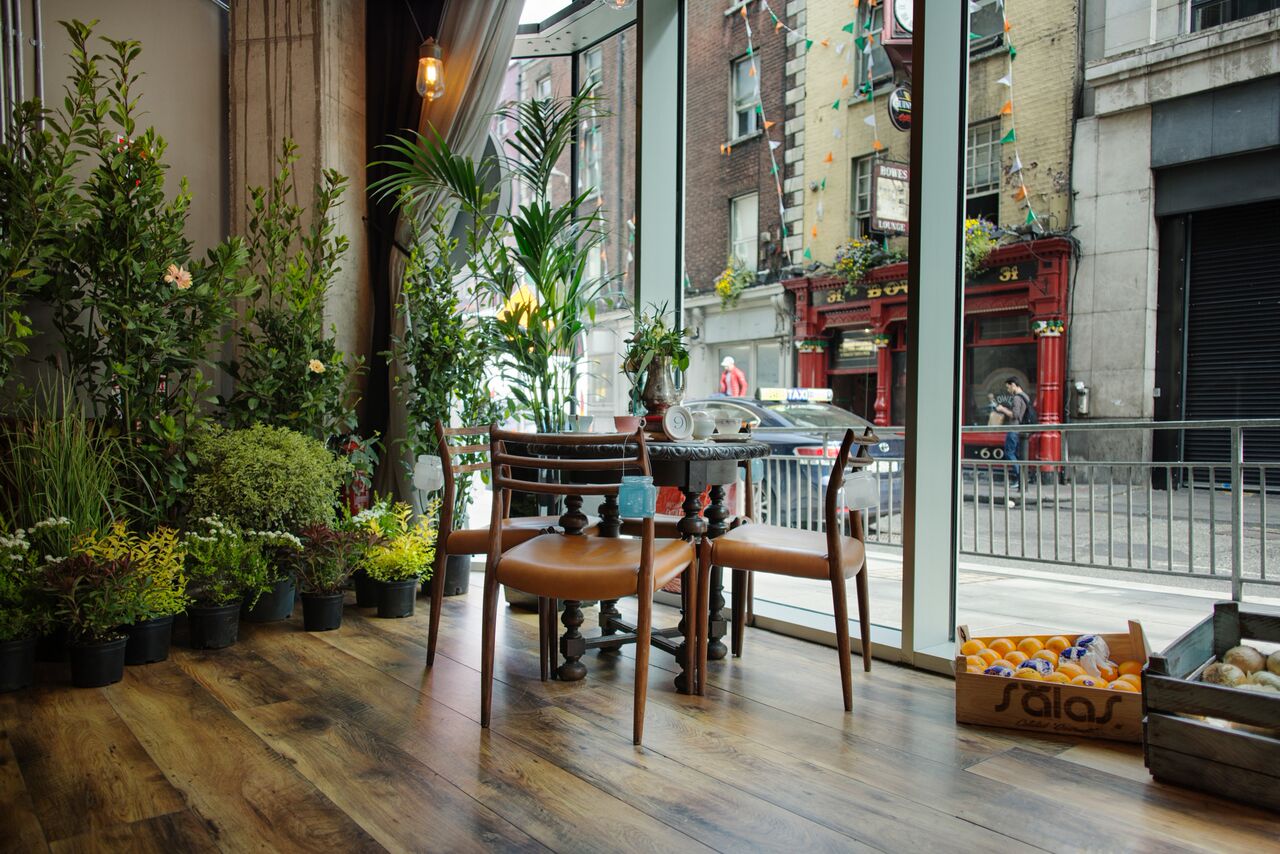 on both TV and radio, with
some episodes taking place at Medley. (His mum
taught him everything he knows about cooking.) It’s
likely he will be coming by your table to work his
charm and make sure you’re happy with your
experience.
on both TV and radio, with
some episodes taking place at Medley. (His mum
taught him everything he knows about cooking.) It’s
likely he will be coming by your table to work his
charm and make sure you’re happy with your
experience.
All the ingredients at Medley are
locally sourced by Chef Vincent Blake, including
Irish beef dry aged for 28 days, lamb, pork, duck,
game and chicken.
Every
day there is an extensive buffet offering an array
that begins with sirloin steak in a brandy cream
sauce and goes on to red chicken coconut curry,
charcuterie, navarin of lamb casserole and much
else. At
breakfast there is potato hash with bacon and
sausage; Cullen skink (a breakfast soup with smoked
haddock, potatoes and leeks that is an acquired
taste); and excellent artisanal breads. The wine
list is surprisingly meager.
Open for
breakfast and lunch daily.
CENTRAL
LODGINGS
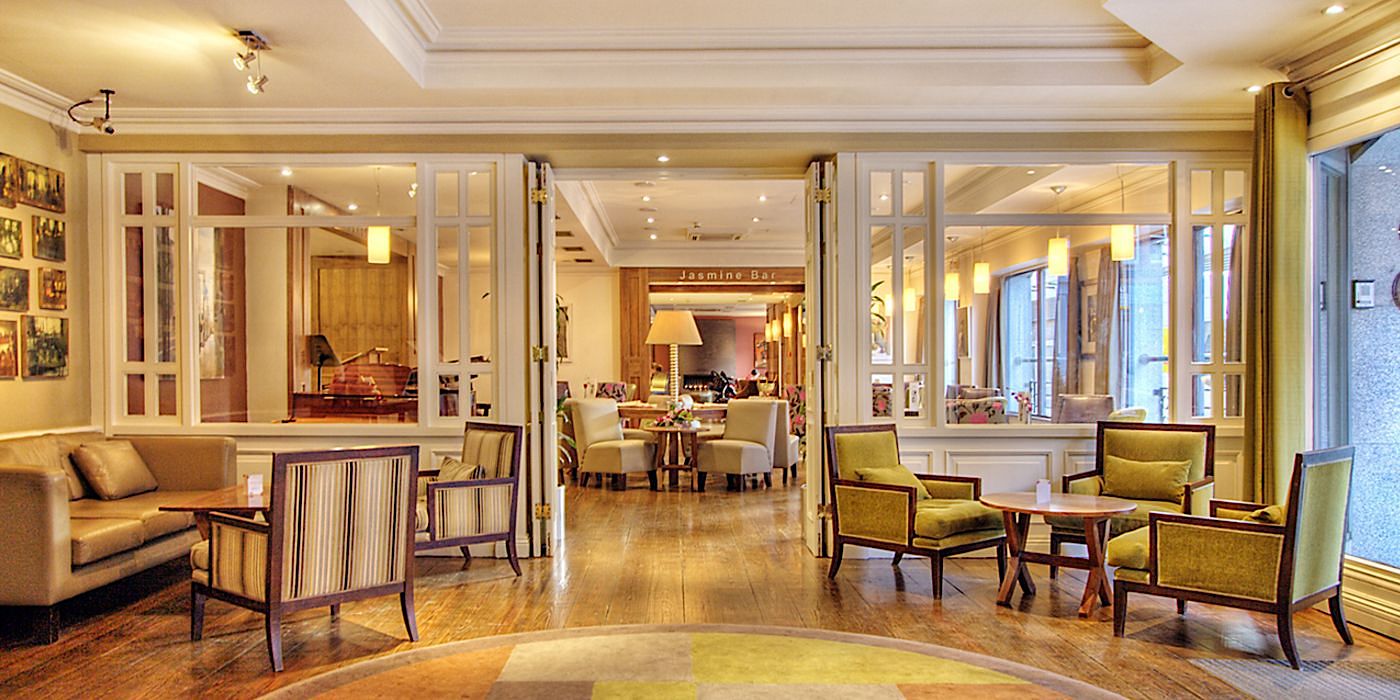 After
a real slump in 2008, Dublin’s hotels have started
to bounce back and increase in number. Since it is
not a large city, staying central is easy enough. (A
Four Seasons Hotel a wee bit outside of town
foundered and was turned into an Intercontinental.) On my
last trip I could not have been better located than
at the boutique Brooks Hotel
on Drury Street, and just a block or two from
everywhere you’d want to visit, shop or dine,
including Grafton and Nassau Streets, Trinity
College and St. Stephen’s Green. There’s also a
parking lot right across the street, which comes in
handy.
After
a real slump in 2008, Dublin’s hotels have started
to bounce back and increase in number. Since it is
not a large city, staying central is easy enough. (A
Four Seasons Hotel a wee bit outside of town
foundered and was turned into an Intercontinental.) On my
last trip I could not have been better located than
at the boutique Brooks Hotel
on Drury Street, and just a block or two from
everywhere you’d want to visit, shop or dine,
including Grafton and Nassau Streets, Trinity
College and St. Stephen’s Green. There’s also a
parking lot right across the street, which comes in
handy.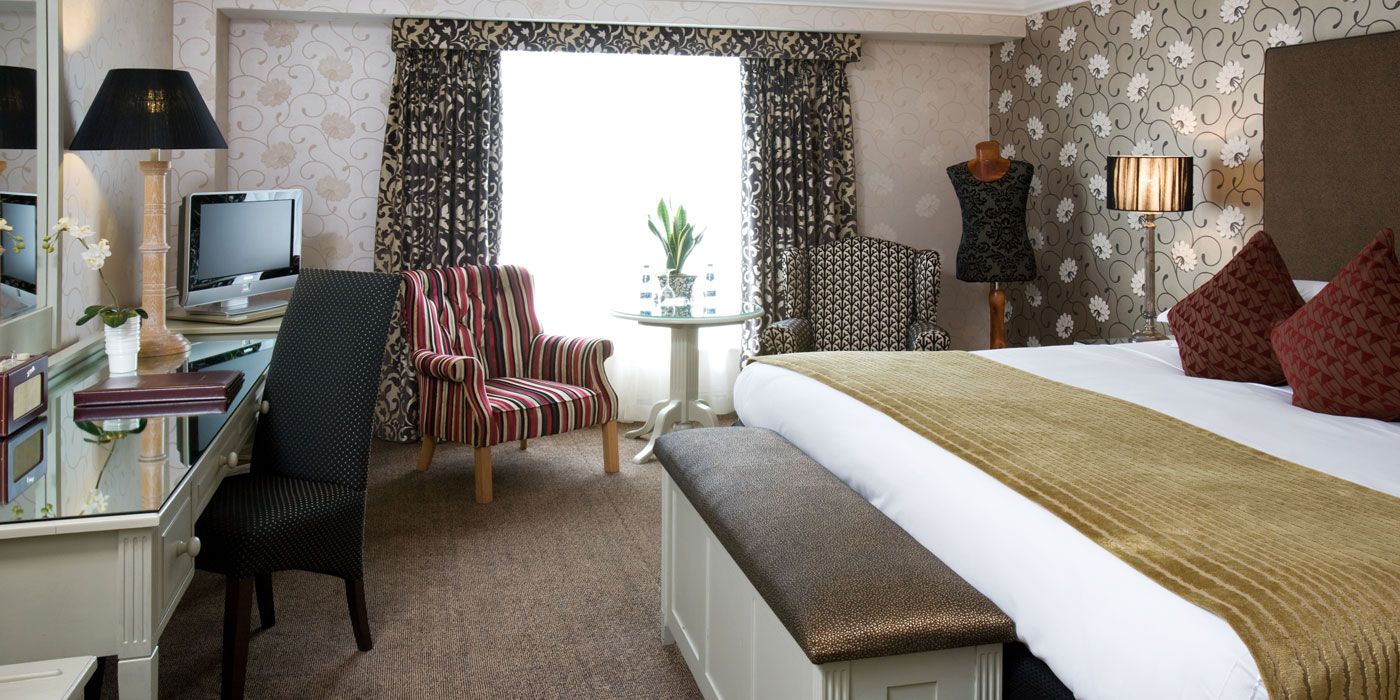
Opened in 1996 and still celebrating
its 20th anniversary, Brooks Hotel now has 100
rooms, a bright modern restaurant named Francesca’s
(which sounds Italian but is more Irish, and they
make a fine club sandwich in the lounge), and even a
very comfortable cinema room you can rent.
The guest rooms are commodious,
the bathrooms well equipped, the WiFi complimentary,
and the service staff eager to assist you with that
special kind of Irish cordiality not easy to
reproduce anywhere else.
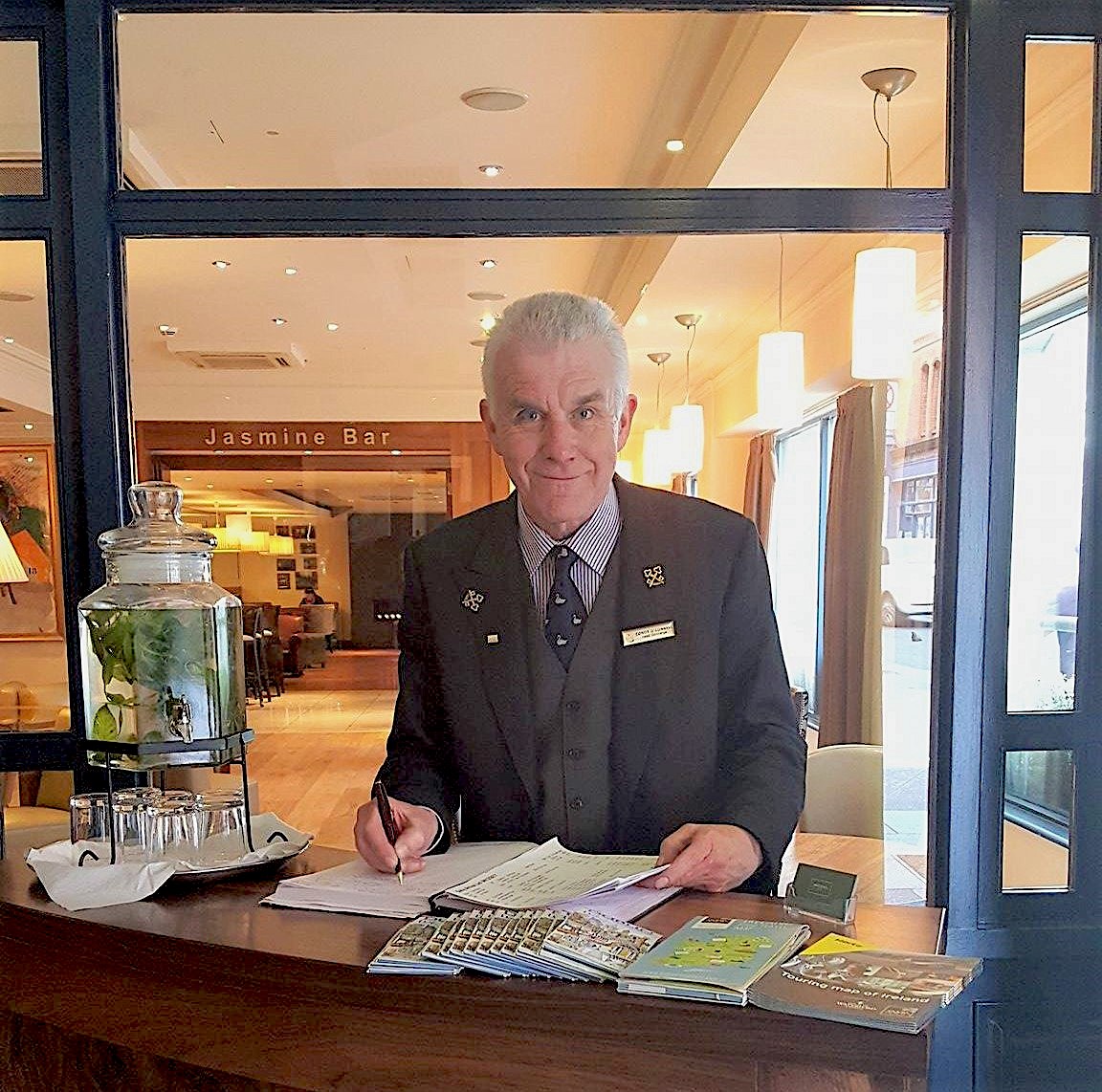 This
is epitomized by the figure of Conor O’Connell (left), a tall,
white-haired Dubliner who looks like an
affable version of Samuel Beckett. His eyebrows rise
when he spots a new guest or a regular—eight out of
ten are repeat visitors. He is the greeter and the one
who bids you goodbye, always in his concierge dark
blue vested suit, his Les Clef d’Or gold pins on the
lapels, and his well-tied club cravat. Within seconds,
you will be on a first name basis with Conor, and
there’s nothing you can request of him that he seems
not to have already anticipated, including a lot of
inside info he readily volunteers, like the
easy-to-miss Little Museum of Dublin.
This
is epitomized by the figure of Conor O’Connell (left), a tall,
white-haired Dubliner who looks like an
affable version of Samuel Beckett. His eyebrows rise
when he spots a new guest or a regular—eight out of
ten are repeat visitors. He is the greeter and the one
who bids you goodbye, always in his concierge dark
blue vested suit, his Les Clef d’Or gold pins on the
lapels, and his well-tied club cravat. Within seconds,
you will be on a first name basis with Conor, and
there’s nothing you can request of him that he seems
not to have already anticipated, including a lot of
inside info he readily volunteers, like the
easy-to-miss Little Museum of Dublin.
AS
FOR FISH AND CHIPS.
. .
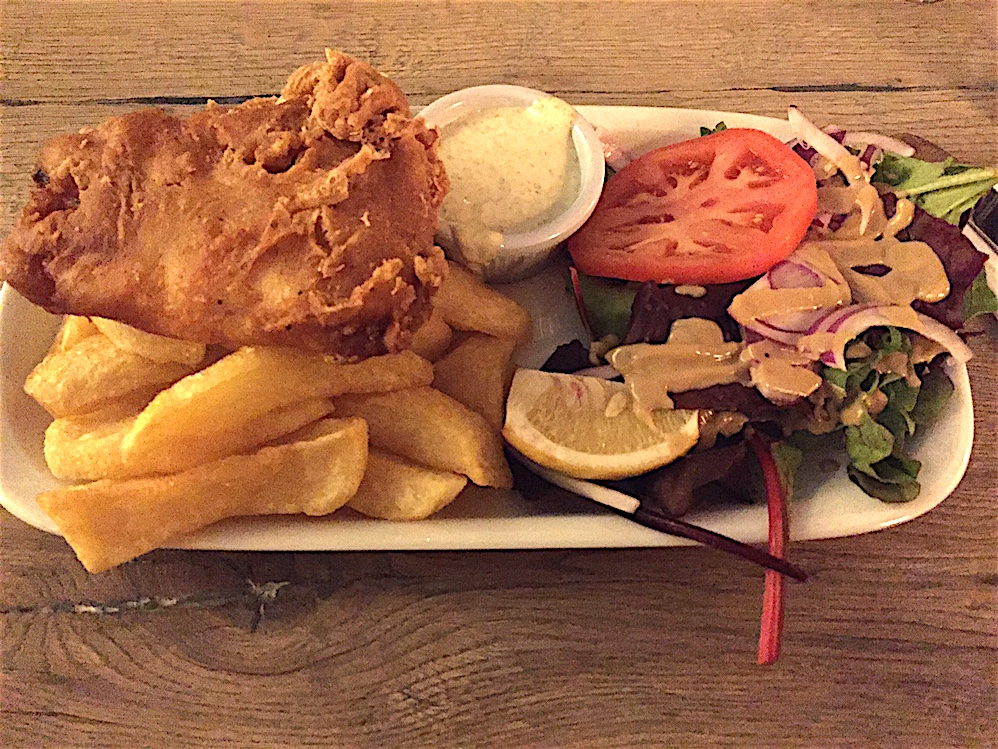
Fish and Chips
at The Front Door
As a staple of food
culture throughout the UK and Ireland, fish and
chips, like all prole food, can be a great balm to
the spirit or a real let-down. I most
certainly recall in years past enough examples of
ammonia-smelling fish, mushy breading and oozing
grease to put me off fish and chips for good, but
that was then.These days, you’ll find that Irish
cooks are expending the same energies on fish and
chips as American chefs are hamburgers. The key to
getting the best is to go when a place is at its
busiest and turn-over high.
I most
certainly recall in years past enough examples of
ammonia-smelling fish, mushy breading and oozing
grease to put me off fish and chips for good, but
that was then.These days, you’ll find that Irish
cooks are expending the same energies on fish and
chips as American chefs are hamburgers. The key to
getting the best is to go when a place is at its
busiest and turn-over high.
From what I learned, 95 percent
of the fish-and-chips shops in suburban Dublin are
run by Italians, for no particular reason, under an
unofficial group calling itself the “Irish-American
Chipper Association.”
In Dublin itself you’ll get into an easy and
fierce argument as to which shop is the best, but
few seem to dispute that Beshoff Bros Seafood Restaurant, with
several branches,
would rank near the top of most lists.
“Our story begins in 1905, on
the sea-washed decks of the Battleship ‘Potemkin,’”
reads Beshoff’s website, “when Ivan Beshoff (right) first
set sail with the famous Russian Imperial Tsarist
fleet. Eight years later he arrived in Dublin and
began building what, by 1939, would be the origin of
a legacy that has so far spanned three generations,
Beshoff Bros fish n’ chips.” Ivan died at the age of
104, but this is still proudly a family business.
Battleship ‘Potemkin,’”
reads Beshoff’s website, “when Ivan Beshoff (right) first
set sail with the famous Russian Imperial Tsarist
fleet. Eight years later he arrived in Dublin and
began building what, by 1939, would be the origin of
a legacy that has so far spanned three generations,
Beshoff Bros fish n’ chips.” Ivan died at the age of
104, but this is still proudly a family business.
Some men were born to create beef
Wellington, others to perfect fish and chips.
❖❖❖
TO BE ON EVERYONE'S RADAR
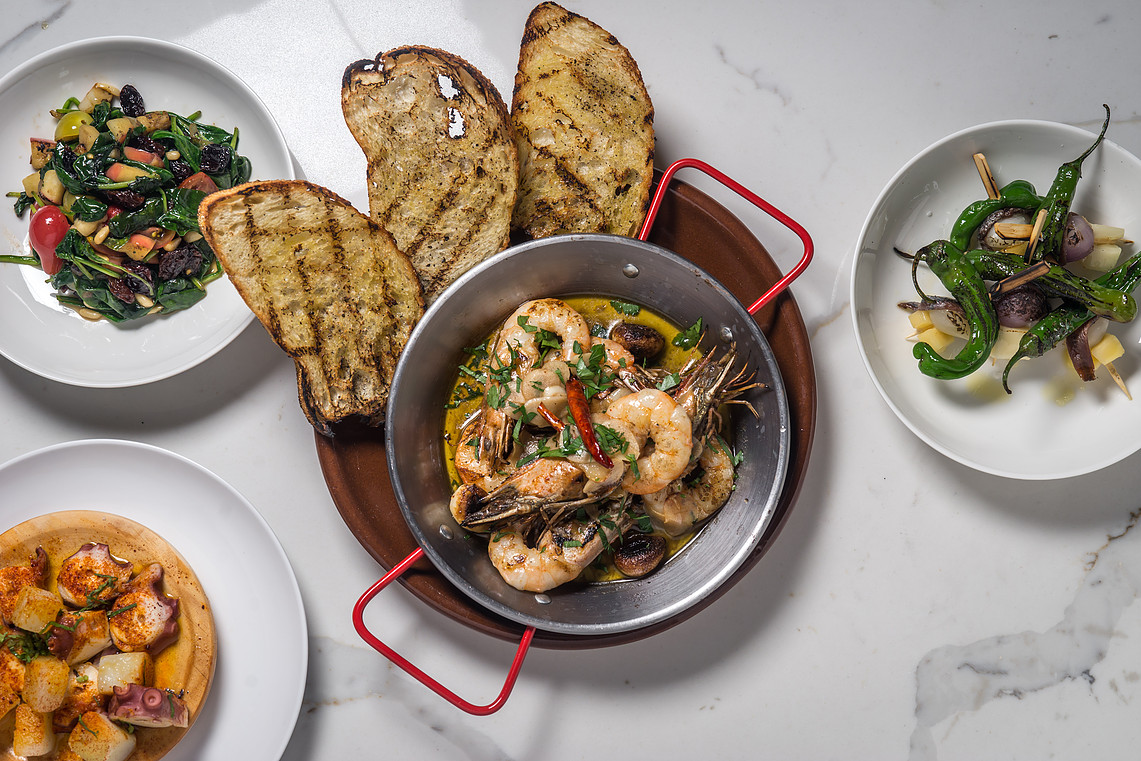
Red shrimp in garlic at Lamano
LAMANO
265 West 20th Street
212-741-2398
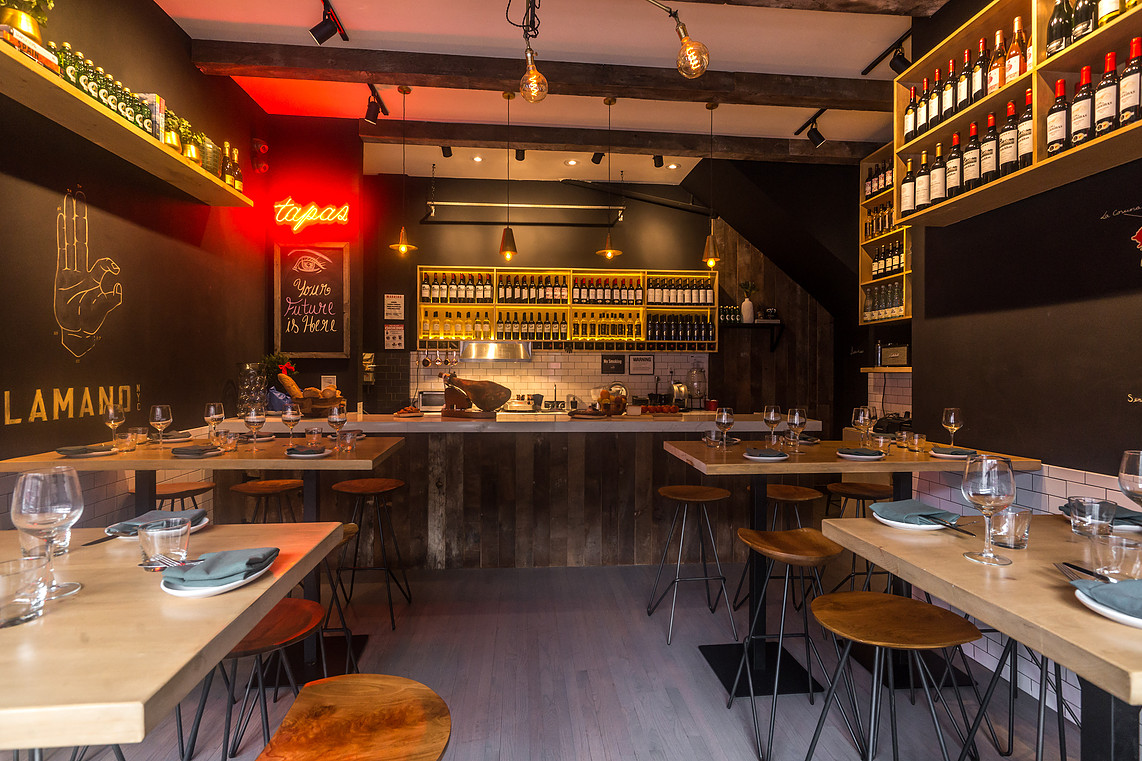 While
Chelsea has long had a slew of good, small
restaurants and eateries, like Alta Linea, Cull
& Pistol and The Red Cat, it has largely avoided
becoming a caterwauling hipster foodie destination
like the Lower East Side and Bushwick. Lamano is
small, but surprisingly not all that loud, a very
friendly and fast-paced storefront closer to a
Basque-style tapas (or pintxos)
wine bar than other Spanish spots around town,
although here you don’t belly up to the bar to
order, as you would in San Sebastián.
While
Chelsea has long had a slew of good, small
restaurants and eateries, like Alta Linea, Cull
& Pistol and The Red Cat, it has largely avoided
becoming a caterwauling hipster foodie destination
like the Lower East Side and Bushwick. Lamano is
small, but surprisingly not all that loud, a very
friendly and fast-paced storefront closer to a
Basque-style tapas (or pintxos)
wine bar than other Spanish spots around town,
although here you don’t belly up to the bar to
order, as you would in San Sebastián.
Lamano is owned by Jorge Guzman
Hospitality with chef-partner Mario Hernandez, who
is Mexican born. From a tiny kitchen area in full
view of the
tall chairs and elevated tables that encourage
sharing, Hernandez works feverishly to send out dish
after dish, more or less when they’re ready, and the
only real problem is to avoid ordering too much.
Just about everything is so savory you’ll need to
prove your camaraderie by not scarfing up the food
on 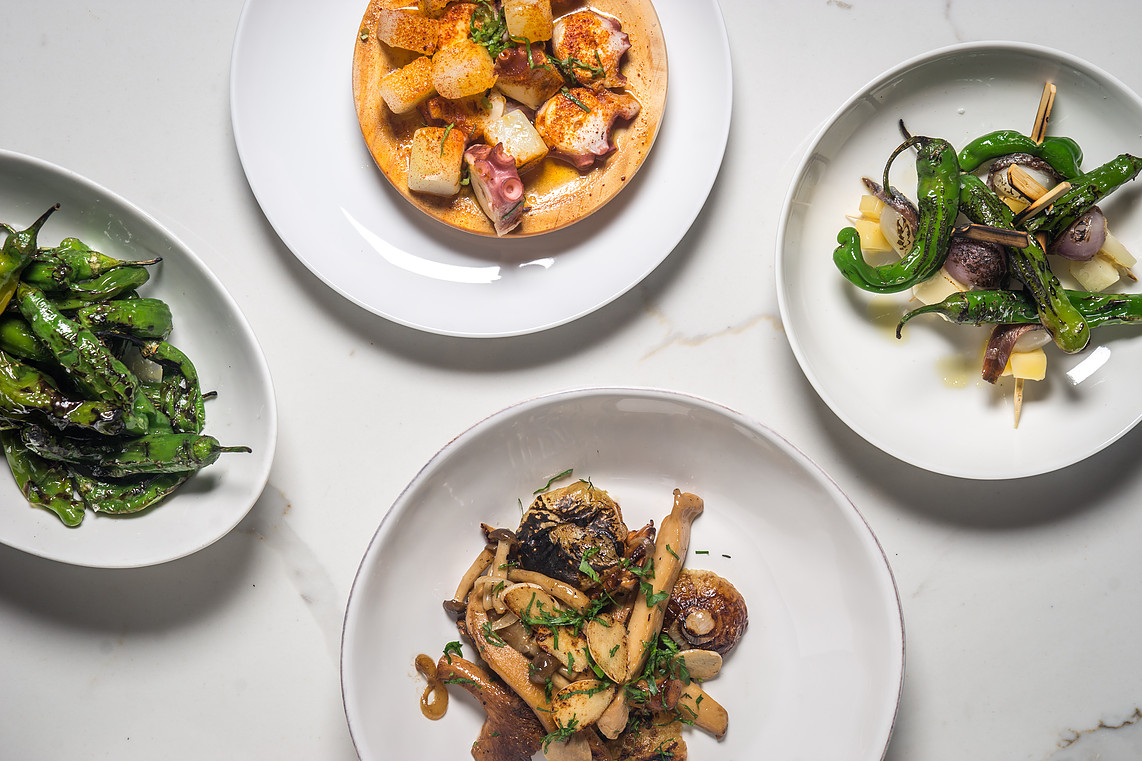 each other’s plates.
each other’s plates.
It’s the kind of
place you begin with either a glass of sparkling cava or, as
we did, a pitcher of way-too-easy-to-drink sangria,
while you nibble on morcilla
blood sausage
($8) and boquerones (anchovies) with
caramelized onions, Idiazabal cheese and garlic
chips splashed with Riesling wine ($8). The
classic tomato-smeared country bread called pan con tomate
($7) is requisite—but be aware that you get a lot of
bread on every dish—and then you must decide on an
array of items that go well beyond what you might
find in the average tapas bar: croquetas with
Serrano and aïoli ($10); marvelous and very pretty gambas red
shrimps in garlic sauce ($16); poached
octopus with potatoes ($18); or course crispy hot patatas bravas
($8).
The wine list is well selected
for this kind of food, compact but all you really
need, with no wine by the glass more than $12.
It’s hard to imagine anyone
leaving Lamano not feeling quite happy, perhaps with
a little buzz on.
Dinner nightly.
SARAGHINA BAKERY &
RESTAURANT
435
Halsey Street
718-574-0010
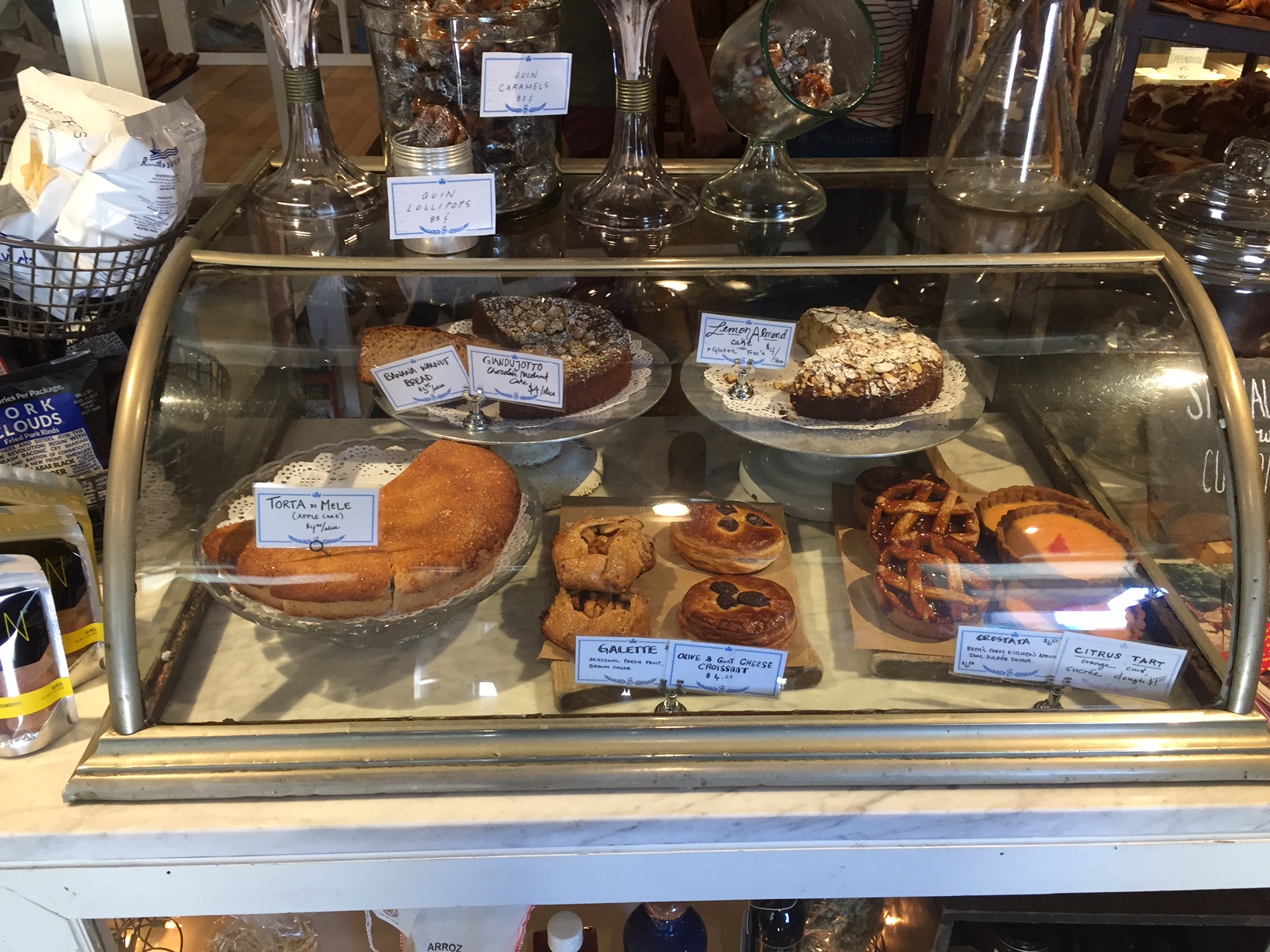
Brooklyn has never wanted
for good pizzerias, and the hyper-praise heaped on
Roberta’s has made it seem that eyesore-ugly
Bushwick eatery invented pizza. The fact is, there
has always been great pizza of various stylizations
all over NYC, and the endless debates about which
place serves the best pie has become a tiresome
cliché.
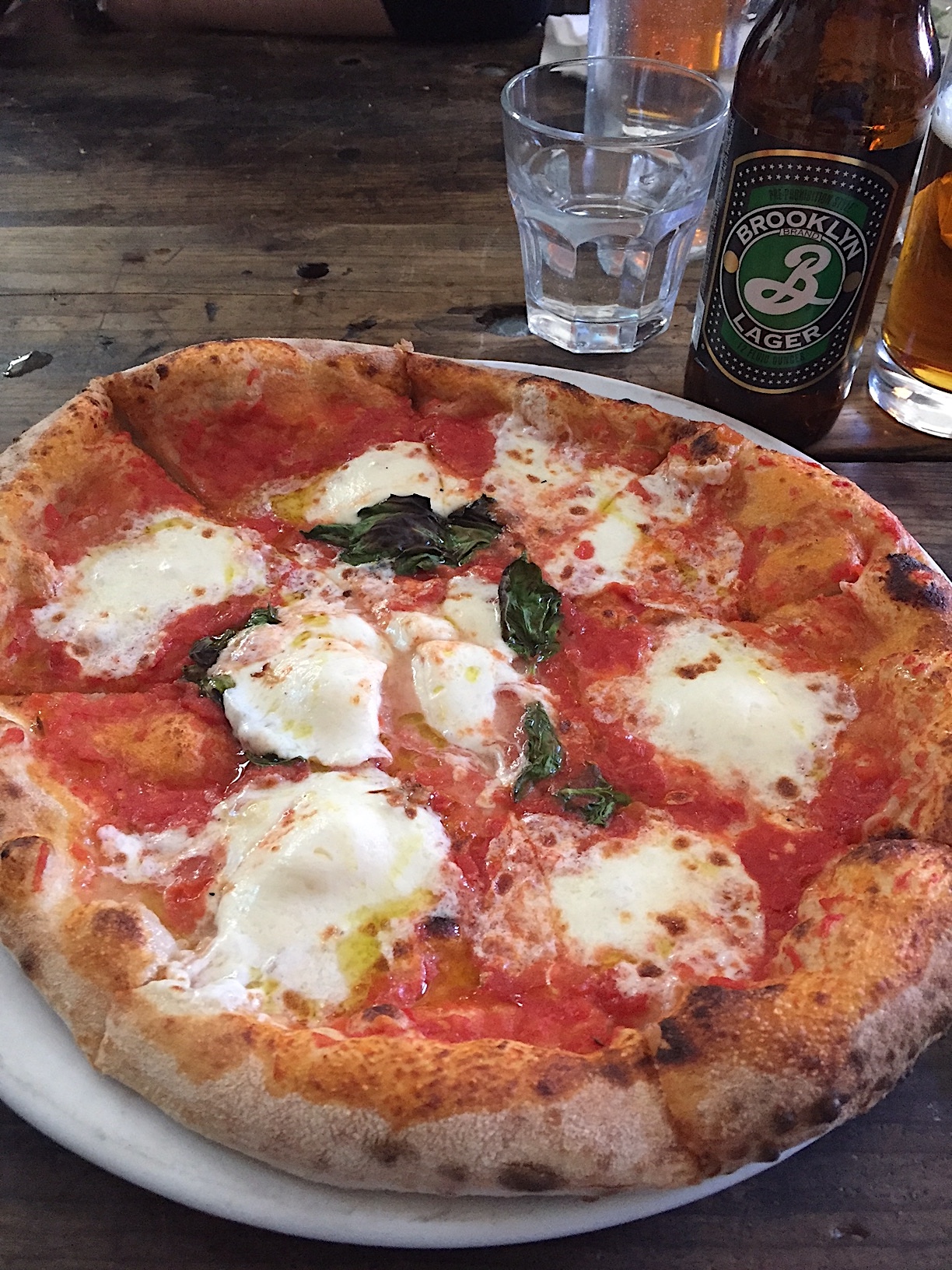 The owner of
Saraghina Bakery & Restaurant in
Bedford-Stuyvesant handily proves the point, having
attracted a young, appreciative clientele, with lots
of kids in tow, by following a childhood dream. “As
kids, we wanted to eat pizza every day,” owner
Edoardo Mantelli writes on his website, “and as
adults we are able to make our dream a reality and
can obsessively eat (and make) pizza without
reprimand. . . . We aim to recreate the food we ate
growing up in Italy, the food we craved as we rushed
home from school or a good soccer game, the kind of
meals our mothers prepared with love and the
freshest ingredients from the local mercato. As
in any good Italian casa, our home was always filled
with sound, but when the aroma of mamma’s cooking
filled the air, we would race to the table and then
there was nothing but silence. . . . We are not
looking to re-invent the pizza-wheel, rather we
continue on in the tradition of our mothers using a
very simple and pure way of cooking and, of course,
amore.”
The owner of
Saraghina Bakery & Restaurant in
Bedford-Stuyvesant handily proves the point, having
attracted a young, appreciative clientele, with lots
of kids in tow, by following a childhood dream. “As
kids, we wanted to eat pizza every day,” owner
Edoardo Mantelli writes on his website, “and as
adults we are able to make our dream a reality and
can obsessively eat (and make) pizza without
reprimand. . . . We aim to recreate the food we ate
growing up in Italy, the food we craved as we rushed
home from school or a good soccer game, the kind of
meals our mothers prepared with love and the
freshest ingredients from the local mercato. As
in any good Italian casa, our home was always filled
with sound, but when the aroma of mamma’s cooking
filled the air, we would race to the table and then
there was nothing but silence. . . . We are not
looking to re-invent the pizza-wheel, rather we
continue on in the tradition of our mothers using a
very simple and pure way of cooking and, of course,
amore.”
That’s as good a description as I
could give of the atmosphere at Saraghina, which,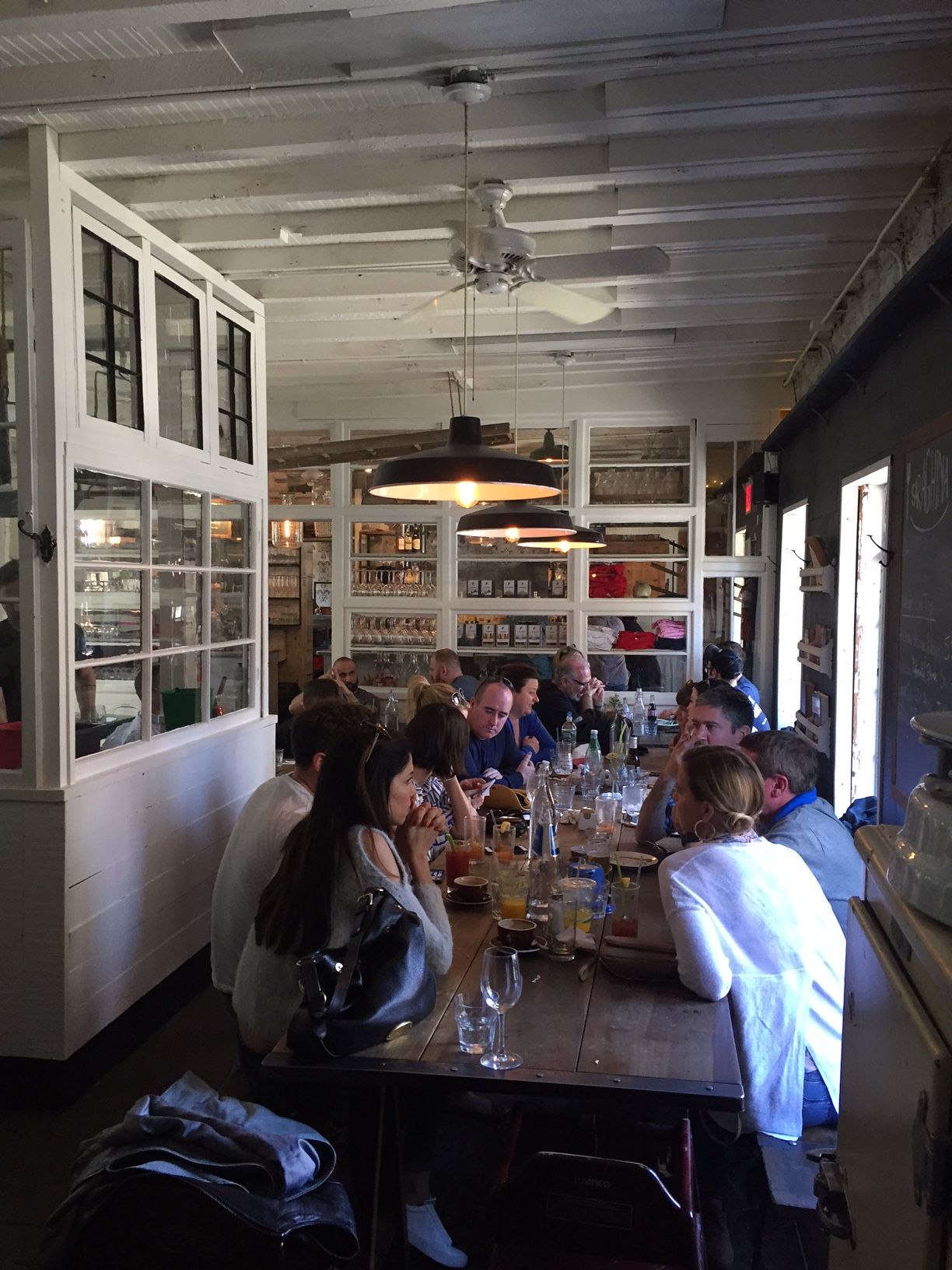 in addition to two rustic
dining rooms, has a splendid bakery and pasta shop
attached. For
weekend brunch the place is packed, and the staff
couldn’t be nicer about letting you know when a
table will turn over, taking your cell phone number
to call you in advance.
in addition to two rustic
dining rooms, has a splendid bakery and pasta shop
attached. For
weekend brunch the place is packed, and the staff
couldn’t be nicer about letting you know when a
table will turn over, taking your cell phone number
to call you in advance.
The place has plenty of
charm—whitewashed brick walls, wood beams, hanging
lamps, a long communal table, and a bar-counter in
front. The waiters are fast on their feet and very
friendly, the noise level is moderate, and starting
up a conversation with the party next to yours
happens easily.
The Neapolitan-style pizza, with
ten toppings—ranging from a specialty with ricotta,
housemade mozzarella, bok choy, guanciale and garlic
chips ($20) to one with mozzarella, hot coppa salami,
roasted spicy artichokes and basil ($17)—are as good
as any you’ll find in Naples, or elsewhere in
Brooklyn. The huge brunch omelets and egg specials
($11-$16), along with an array of well-made panini
($10-$15), are easy to share. At
dinner, three pastas ($15-$18) and three main 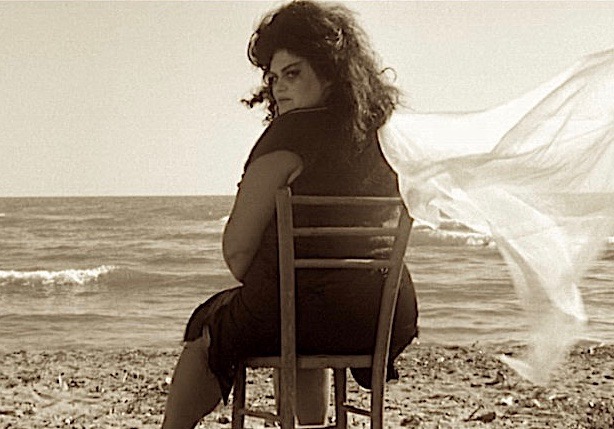 courses ($28-$30) are
offered. This kitchen knows just how much it can
accomplish well.
courses ($28-$30) are
offered. This kitchen knows just how much it can
accomplish well.
The wine list is solid and fits
this kind of food to a tee; mark-ups can be
reasonable or on the high side.
Saraghina
has both sauce and sass; La Saraghina (left) was the
wild, fat rumba-dancing puttanta
in Fellini’s film 8 ½. It’s
all in fun, and you should feel right at home in
what seems like Mantelli’s own tasty version of Amarcord.
Open for breakfast, lunch and dinner daily;
Brunch Sat. & Sun.
❖❖❖
NOTES FROM
THE WINE CELLAR
By John Mariani
LEDE WINES AIM FOR
PURITY OF STYLE
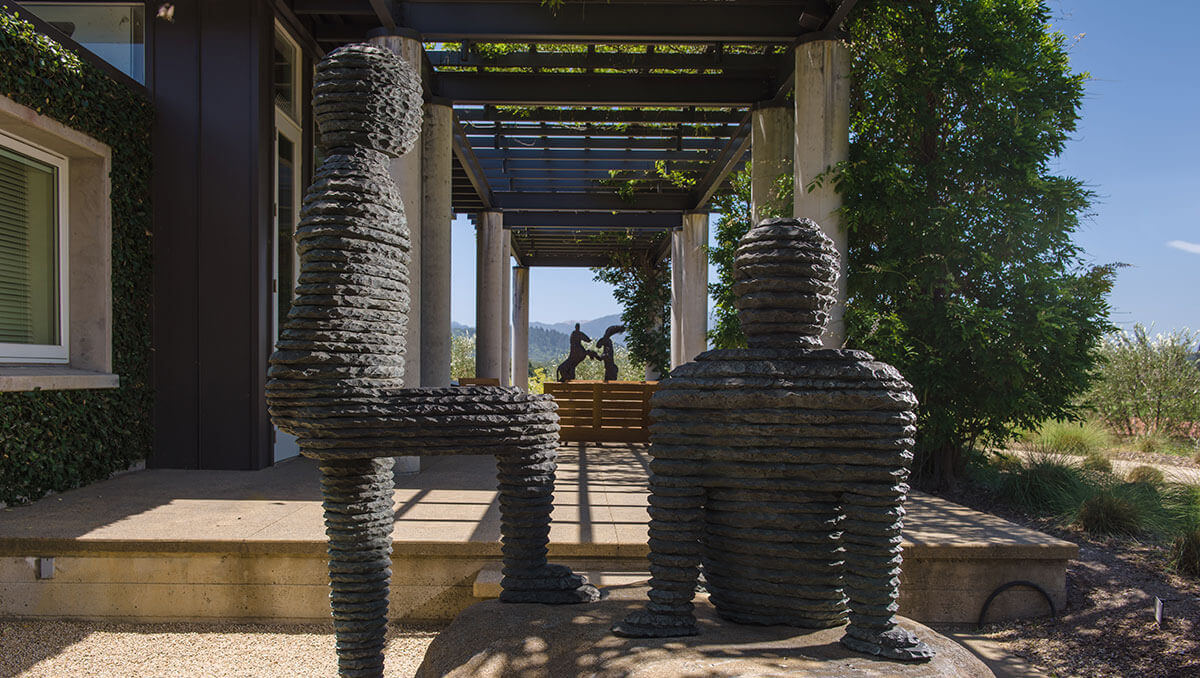
A Canadian construction
company entrepreneur who buys a vineyard in Napa
Valley to make Bordeaux-style wines and names
them after his favorite rock songs is about par
for the course for  the idiosyncratic
investors in California viniculture. That’s what
Cliff Lede (pronounced lay-dee) did fifteen
years ago when he built a state-of-the-art
winery and cave system on 60 acres in the Stags
Leap district, giving his vineyard blocks names
like “Dark Side of the Moon” and “My
Generation.”
the idiosyncratic
investors in California viniculture. That’s what
Cliff Lede (pronounced lay-dee) did fifteen
years ago when he built a state-of-the-art
winery and cave system on 60 acres in the Stags
Leap district, giving his vineyard blocks names
like “Dark Side of the Moon” and “My
Generation.”
Lede (right) also acquired Breggo
Cellars in Anderson Valley in 2009 and
re-launched in 2014 as FEL Wines in the Anderson
Valley, in homage to his mother, Florence Elsie
Lede; then two years later he acquired Savoy
Vineyard. Everything
was to be first class, so, of course, Lede had to
have a place for guests to stay, which in 2005
turned out to be the five-room Poetry Inn,
designed by Howard Backen.
 Texas-born
Christopher Tynan was hired to carry Lede’s banner
of Bordeaux-style wines and commitment to the
environment.
Just as significant is the estate’s
insistence on as little intervention in the
vineyards as possible and how the grapes are
treated, in contrast to a far more manipulative
approach that is the general rule in Napa Valley.
Texas-born
Christopher Tynan was hired to carry Lede’s banner
of Bordeaux-style wines and commitment to the
environment.
Just as significant is the estate’s
insistence on as little intervention in the
vineyards as possible and how the grapes are
treated, in contrast to a far more manipulative
approach that is the general rule in Napa Valley.
“We pay for acreage rather than
tonnage,” Lede’s VP and GM Remi Cohen told me over
dinner at Union Square Café in New York, meaning
that the small-lot winery does not encourage
production as much as it values perfect grapes,
consistency and loyalty to growers. As
brand ambassador, Cohen is the public face of Lede
and her résumé indicates the kind of knowledge,
professionalism and marketing canny Cliff Lede is
seeking at every level of his enterprise.
Born and raised in New Jersey,
Cohen set her sights on 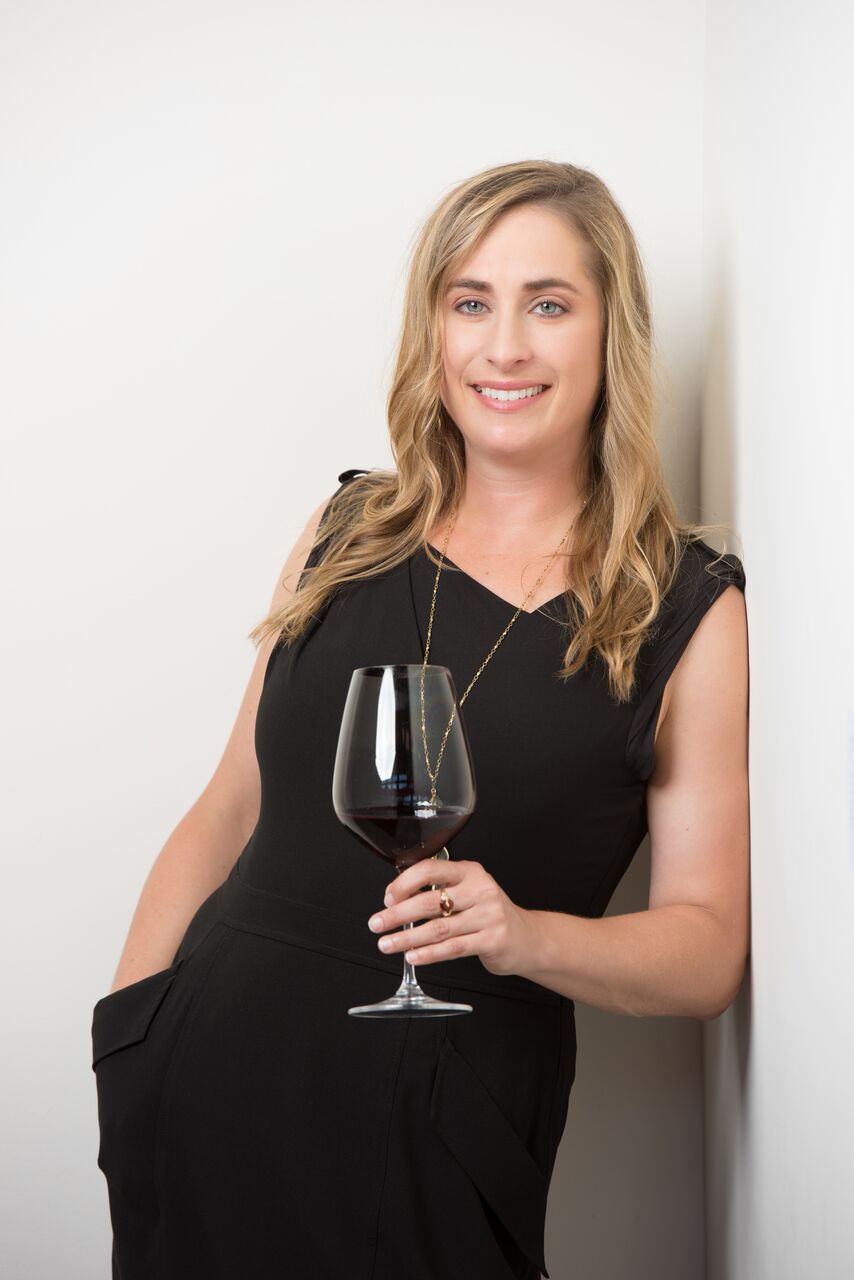 becoming a doctor or genetics
professor at U.C. Berkeley, graduating with a
degree in molecular and cellular biology—a
discipline that later gave her significant segue
into studying viticulture and enology at UC Davis,
tagging on an MBA at Golden Gate University along
the way.
becoming a doctor or genetics
professor at U.C. Berkeley, graduating with a
degree in molecular and cellular biology—a
discipline that later gave her significant segue
into studying viticulture and enology at UC Davis,
tagging on an MBA at Golden Gate University along
the way.
By 2001 she was working the
harvest at Saintsbury in Carneros, then became
vineyard manager at Bouchaine and soon was the VP
of operations at Merryvale. In 2012
Cohen founded her own viticultural and winemaking
consultancy called Vines to Wine, which led to her
introduction to Cliff Lede.
Cohen is
a very impressive person: She lectures on
agricultural sustainability, writes a column for Vineyard
& Winery Management, serves on the board
of the Napa Valley Grapegrowers and the Stags Leap
District Winegrowers Association, and is a Court
of Master Sommelier certified sommelier.
Like
winemaker Tynan, previously at Colgin,
Cohen shares Lede’s belief in low-yield vines from
select sites whose wines express their individual
terroir. The
wisdom of this process may be best sampled in
Lede’s 2016 Sauvignon Blanc ($25), composed of 82%
Sauvignon Blanc, a sizable 14% Semillon, 3%
Sauvignon Vert and 1% aromatic Muscat Canelli,
with only 7,700 cases produced. The
14.4% alcohol is high for Sauvignon Blanc, but the
balance and richness of the wine distinguishes it
entirely from the thin, grassy, punch-like flavors
of so much Sauvignon Blanc that has become both
the New Zealand and California style.
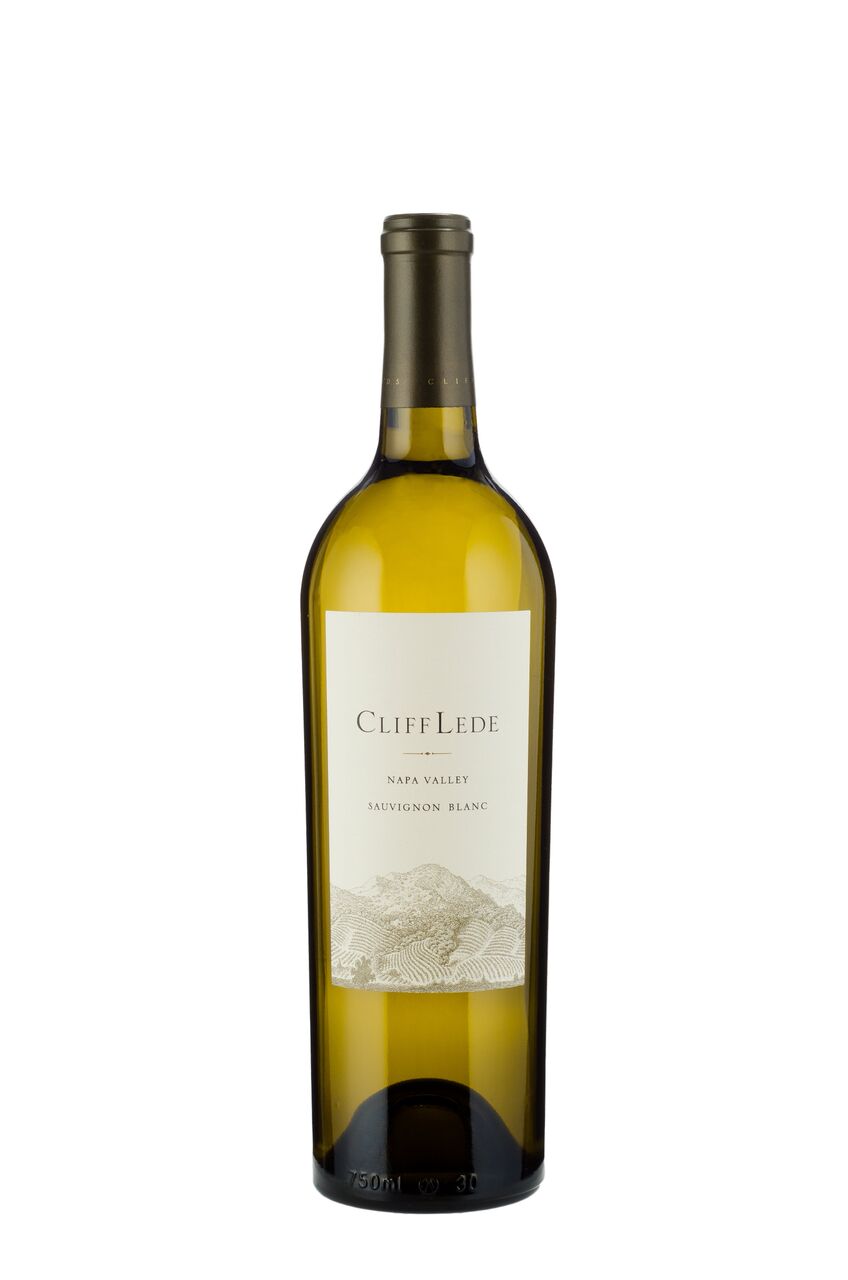
FEL Anderson Valley Pinot Noir
2015 ($38) is actually a little lower in alcohol
than the Sauvignon Blanc, and that is all for the
good. Anderson
Valley has a rep for overripe, brawny, inky Pinot
Noirs, but FEL’s has far more finesse, the tannins
soft, the fruit not overly ripe, the acids in
balance. Sixteen months in oak barrels, 34% of
which were new, give just enough of that component
to increase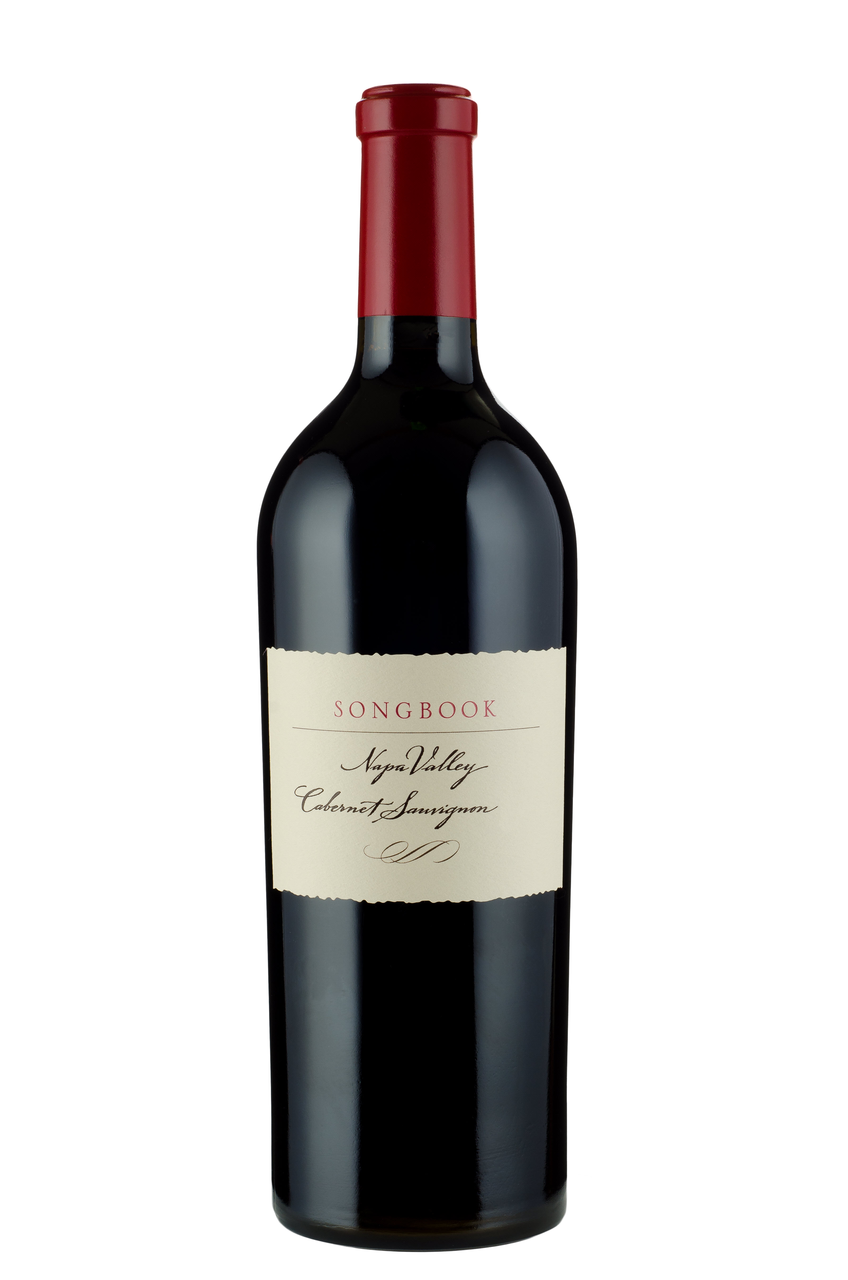 the complexity further.
the complexity further.
I did not have a chance to
taste the flagship Lede wine, Poetry 2013, because
it is sold out, even at $250 (only 822 cases were
made). I
did, however, enjoy the pricey 2013 Songbook
($190), which is very much a Bordeaux blend, with
93% Cabernet Sauvignon, 3% Merlot, 3% Cabernet
Franc, and 1% Petit Verdot, matured for 21 months
in French oak barrels, almost all new. At
14.9% alcohol it skirts being one of those massive
California cabs, instead delivering plenty of dark
berry fruit and spice, with a slight tannic grip
at the finish, which should loosen further in a
year or two.
It is
easy enough to recognize a wine that was
manipulated in the vineyard and crafted in the
winery, but in tasting Lede wines it reminds me
that true craftsmanship begins with a respect for
the source of the main ingredient, which is as
true of fine grapes as it is of the wood used in
making a fine guitar.
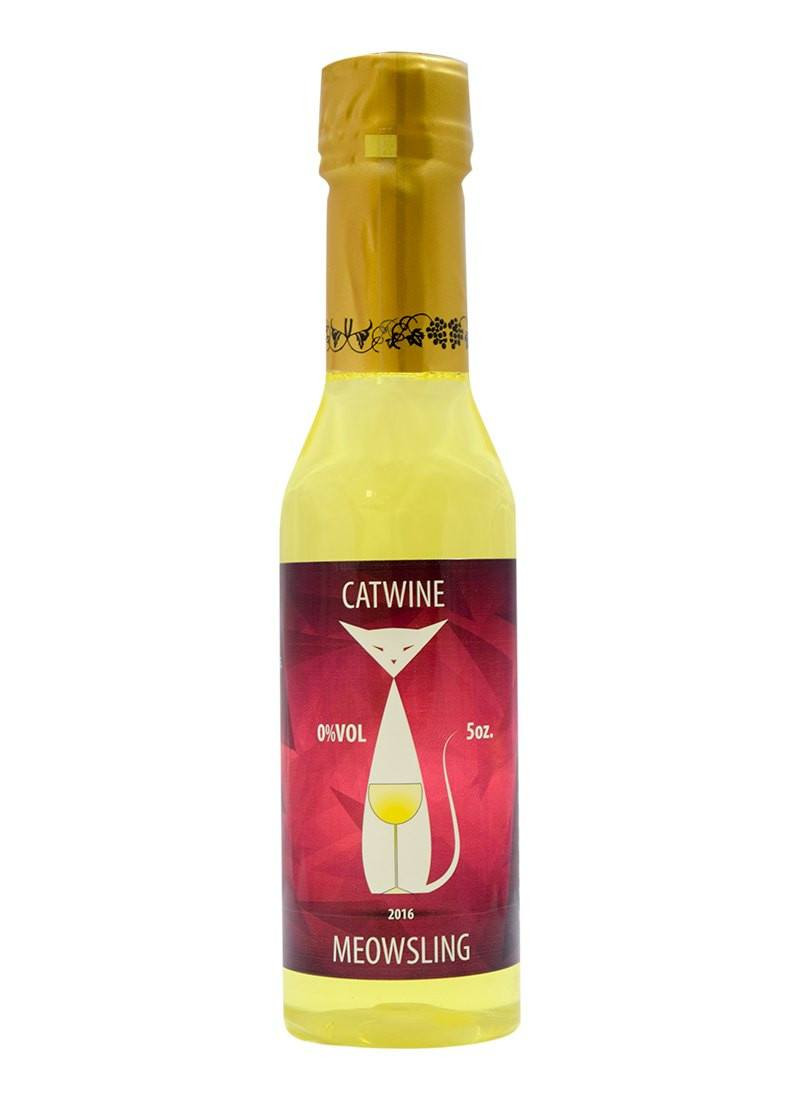
DECLINE OF WESTERN CIVILIZATION
Apollo Peak says it's sold
$500,000 worth of catnip-infused colored water
called "pet wine" at T.J. Maxx, Marshalls, and 200
other stores in just the past year, and now has a
competitor in Florida-based Pet Winery, now
in 40 stores. Names of beverages includ
Catbernet, Moscato, and Purrgundy, and Mëow &
Chandon.
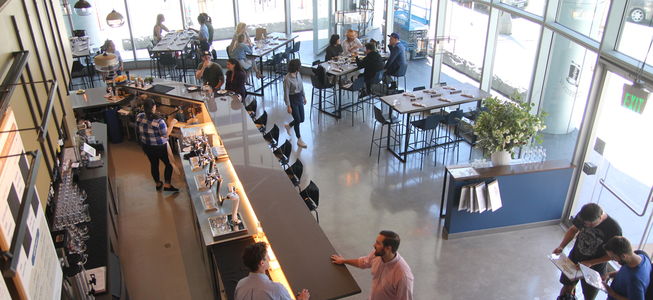 WAITER? WAITER? WAI-TER?
WAITER? WAITER? WAI-TER?
HEY, CAN I
GET SOME SERVICE HERE?
"At
first glance Corridor seems like any other buzzworthy
San Francisco restaurant: low lights, curated playlists,
thoughtful wine list, reclaimed-wood tables set with
stemmed glassware, artisanal china, fine flatware and a
California-inspired American menu of on-trend plates
. . . . It’s a fairly standard fine-dining
operation in most respects, really, except for one
little thing. There are no waiters. No one will
take your order. Instead, when you arrive, you’ll walk
up to a counter to order your entire meal there. You’ll
be handed a discreet GPS device (it does not buzz),
which locates you in the restaurant so a runner can
deliver your food. Once seated, floor staff will refill
water glasses, reorder drinks and add desserts as
needed. Welcome to `fast fine,' a hybrid dining
phenomenon sweeping San Francisco.”—Andrea
Strong, “The Way to Save the Restaurant Industry? Put
the Fast in Fine Dining,” Food Republic
(1/25/17)
Any of John Mariani's books below may be ordered from amazon.com.
 The
Hound in Heaven (21st Century Lion Books)
is a novella, and for anyone who loves dogs,
Christmas, romance, inspiration, even the supernatural, I
hope you'll find this to be a treasured favorite.
The story concerns how, after a New England teacher,
his wife and their two daughters adopt a stray puppy found
in their barn in northern Maine, their lives seem full of
promise. But when tragedy strikes, their wonderful dog
Lazarus and the spirit of Christmas are the only things
that may bring his master back from the edge of
despair.
The
Hound in Heaven (21st Century Lion Books)
is a novella, and for anyone who loves dogs,
Christmas, romance, inspiration, even the supernatural, I
hope you'll find this to be a treasured favorite.
The story concerns how, after a New England teacher,
his wife and their two daughters adopt a stray puppy found
in their barn in northern Maine, their lives seem full of
promise. But when tragedy strikes, their wonderful dog
Lazarus and the spirit of Christmas are the only things
that may bring his master back from the edge of
despair. WATCH THE VIDEO!
“What a huge surprise turn this story took! I was completely stunned! I truly enjoyed this book and its message.” – Actress Ali MacGraw
“He had me at Page One. The amount of heart, human insight, soul searching, and deft literary strength that John Mariani pours into this airtight novella is vertigo-inducing. Perhaps ‘wow’ would be the best comment.” – James Dalessandro, author of Bohemian Heart and 1906.
“John Mariani’s Hound in Heaven starts with a well-painted portrayal of an American family, along with the requisite dog. A surprise event flips the action of the novel and captures us for a voyage leading to a hopeful and heart-warming message. A page turning, one sitting read, it’s the perfect antidote for the winter and promotion of holiday celebration.” – Ann Pearlman, author of The Christmas Cookie Club and A Gift for my Sister.
“John Mariani’s concise, achingly beautiful novella pulls a literary rabbit out of a hat – a mash-up of the cosmic and the intimate, the tragic and the heart-warming – a Christmas tale for all ages, and all faiths. Read it to your children, read it to yourself… but read it. Early and often. Highly recommended.” – Jay Bonansinga, New York Times bestselling author of Pinkerton’s War, The Sinking of The Eastland, and The Walking Dead: The Road To Woodbury.
“Amazing things happen when you open your heart to an animal. The Hound in Heaven delivers a powerful story of healing that is forged in the spiritual relationship between a man and his best friend. The book brings a message of hope that can enrich our images of family, love, and loss.” – Dr. Barbara Royal, author of The Royal Treatment.
 |
The Encyclopedia of American Food and Drink by John F. Mariani (Bloomsbury USA, $35) Modesty forbids me to praise my own new book, but let me proudly say that it is an extensive revision of the 4th edition that appeared more than a decade ago, before locavores, molecular cuisine, modernist cuisine, the Food Network and so much more, now included. Word origins have been completely updated, as have per capita consumption and production stats. Most important, for the first time since publication in the 1980s, the book includes more than 100 biographies of Americans who have changed the way we cook, eat and drink -- from Fannie Farmer and Julia Child to Robert Mondavi and Thomas Keller. "This book is amazing! It has entries for everything from `abalone' to `zwieback,' plus more than 500 recipes for classic American dishes and drinks."--Devra First, The Boston Globe. "Much needed in any kitchen library."--Bon Appetit. |
"Eating Italian will never be the same after reading John Mariani's entertaining and savory gastronomical history of the cuisine of Italy and how it won over appetites worldwide. . . . This book is such a tasteful narrative that it will literally make you hungry for Italian food and arouse your appetite for gastronomical history."--Don Oldenburg, USA Today. "Italian
restaurants--some good, some glitzy--far
outnumber their French rivals. Many of
these establishments are zestfully described
in How Italian Food Conquered the World, an
entertaining and fact-filled chronicle by
food-and-wine correspondent John F.
Mariani."--Aram Bakshian Jr., Wall Street
Journal.
"Equal parts
history, sociology, gastronomy, and just
plain fun, How Italian Food Conquered the
World tells the captivating and delicious
story of the (let's face it) everybody's
favorite cuisine with clarity, verve and
more than one surprise."--Colman Andrews,
editorial director of The Daily
Meal.com. "A fantastic and fascinating
read, covering everything from the influence
of Venice's spice trade to the impact of
Italian immigrants in America and the
evolution of alta cucina. This book will
serve as a terrific resource to anyone
interested in the real story of Italian
food."--Mary Ann Esposito, host of PBS-TV's
Ciao
Italia. "John Mariani has written the
definitive history of how Italians won their
way into our hearts, minds, and
stomachs. It's a story of pleasure over
pomp and taste over technique."--Danny Meyer,
owner of NYC restaurants Union Square
Cafe, The Modern, and Maialino.
|
 |
 |
 |
 |
 |
 |
 |
 |
 Everett Potter's Travel Report:
Everett Potter's Travel Report: 
 Eating Las Vegas
JOHN CURTAS has been covering the Las Vegas
food and restaurant scene since 1995. He is
the co-author of EATING LAS VEGAS – The 50
Essential Restaurants (as well as
the author of the Eating Las Vegas web site: www.eatinglasvegas.
He can also be seen every Friday morning as
the “resident foodie” for Wake Up With the
Wagners on KSNV TV (NBC) Channel 3 in
Las Vegas.
Eating Las Vegas
JOHN CURTAS has been covering the Las Vegas
food and restaurant scene since 1995. He is
the co-author of EATING LAS VEGAS – The 50
Essential Restaurants (as well as
the author of the Eating Las Vegas web site: www.eatinglasvegas.
He can also be seen every Friday morning as
the “resident foodie” for Wake Up With the
Wagners on KSNV TV (NBC) Channel 3 in
Las Vegas.

MARIANI'S VIRTUAL GOURMET
NEWSLETTER is published weekly. Editor/Publisher: John
Mariani.
Editor: Walter Bagley. Contributing Writers: Christopher Mariani,
Robert Mariani, Misha Mariani, John A. Curtas, Geoff Kalish, Mort
Hochstein, and
Brian Freedman. Contributing Photographers: Galina
Dargery. Technical Advisor: Gerry McLoughlin.
To un-subscribe from this newsletter,click here.
© copyright John Mariani 2017

